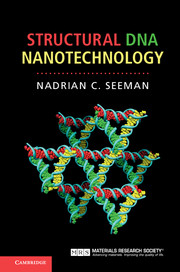Book contents
- Frontmatter
- Contents
- Preface
- 1 The origin of structural DNA nanotechnology
- 2 The design of DNA sequences for branched systems
- 3 Motif design based on reciprocal exchange
- 4 Single-stranded DNA topology and motif design
- 5 Experimental techniques
- 6 A short historical interlude: the search for robust DNA motifs
- 7 Combining DNA motifs into larger multi-component constructs
- 8 DNA nanomechanical devices
- 9 DNA origami and DNA bricks
- 10 Combining structure and motion
- 11 Self-replicating systems
- 12 Computing with DNA
- 13 Not just plain vanilla DNA nanotechnology: other pairings, other backbones
- 14 DNA nanotechnology organizing other materials
- Afterword
- Index
Afterword
Published online by Cambridge University Press: 05 December 2015
- Frontmatter
- Contents
- Preface
- 1 The origin of structural DNA nanotechnology
- 2 The design of DNA sequences for branched systems
- 3 Motif design based on reciprocal exchange
- 4 Single-stranded DNA topology and motif design
- 5 Experimental techniques
- 6 A short historical interlude: the search for robust DNA motifs
- 7 Combining DNA motifs into larger multi-component constructs
- 8 DNA nanomechanical devices
- 9 DNA origami and DNA bricks
- 10 Combining structure and motion
- 11 Self-replicating systems
- 12 Computing with DNA
- 13 Not just plain vanilla DNA nanotechnology: other pairings, other backbones
- 14 DNA nanotechnology organizing other materials
- Afterword
- Index
Summary
So where's it all going? People are trying to make better bricks and bigger origami constructs, and put more automation into the field. Everybody who works in the area knows we need better molecular modeling, particularly better physical models. Everybody wants to know what's next. Figures A-1, A-2, and A-3 are how I end my seminar these days. A-1 asks what's next, A-2 says it's no longer my responsibility, and A-3 reinforces that notion.
Nevertheless, although there are far too many people in the field for it to be my own enclave, that doesn't meant that I don't have my own ideas of what should be pursued. My top priority is to increase the control that we already have. We have improved the 2-turn tensegrity triangle crystals to the point where they diffract to a touch better than 3 Å resolution. We got there by tweaking the sticky ends, and that seems not to be the correct route for the larger triangles that can actually host macromolecules of significant dimensions. Yossi Weizmann's recent progress with knots has encouraged me to see whether synthetic knot topoisomers can be distinguished. Current work with Henry Chapman suggests that there is a major role for DNA nanotechnology to play in the establishment of new scattering methods.
I look forward to extending the role of DNA to control the structure of matter on larger scales, such as the micron scale, as well as on the nanoscale. By contrast, I foresee the assembly line as the first of its kind, but certainly not the last. With luck, we'll be able to drop the scale on it, so that real chemical assembly can be programmed at the level of bonds. This will certainly be a challenge, but that's what Science is all about. Nature does it, meaning that sooner or later, we can too. It's just a matter of time.
- Type
- Chapter
- Information
- Structural DNA Nanotechnology , pp. 248 - 250Publisher: Cambridge University PressPrint publication year: 2016

